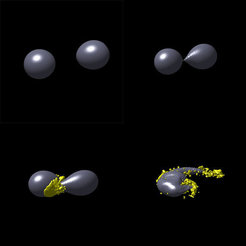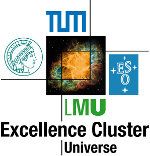Physics and Neutrino Physics Around Hot Neutron Stars
Neutron star birth in supernovae

Neutron stars are born as extremely hot objects when the cores of highly evolved, massive stars become gravitationally unstable and collapse while the stars blow up as supernovae. Neutron stars have diameters of only 10-15 kilometers (like the city of Munich), but contain 1.5 times the mass of our Sun, compressed to densities higher than that of matter in atomic nuclei. The neutrons and remaining ten percent of protons and electrons are so tighly packed that they touch each other and feel strong repulsive forces, which stabilize the star against its enormous, inward pulling gravitational attraction.
In the transition from the initial, moon-size stellar core to the ultra-compact state of the neutron star, a huge amount of energy is released and radiated away by neutrinos, ghost-like elementary particles of which billions can cross the Earth without a single interaction. In the dense and hot environment of the neutron star, however, neutrinos are trapped for several seconds and interesting and exotic processes can take place.
The escaping neutrinos are not only thought to trigger the supernova explosion itself. They also set the conditions for the formation of new trans-iron elements in the innermost ejecta of the stellar explosion. On their way out to the surface of the dying star, neutrinos of different kinds can convert into each other in so-called neutrino-flavor transformations. Tens of thousands of neutrinos from the next Galactic supernova will be captured in deep-underground experiments like IceCube at the South Pole, SuperKamiokande in Japan, and Borexino in the Gran Sasso Laboratory. Such measurements will offer a unique possibility to peer directly into the otherwise obscured central regions of a dying star. Theoretical predictions of the expected neutrino signals will be essential for interpreting the information carried by the neutrinos.
Neutron stars in merging compact binaries

Binary systems that consist of two massive stars sometimes can survive the supernova explosions of the two stars and give birth to two neutron stars in a close orbit around each other. Currently about a dozen of such neutron-star binaries are known in the Milky Way and offer exiting possibilities to test Einstein's General Relativity. From this theory one predicts the systems to live only for a finite time because they lose energy and angular momentum by the emission of gravitational waves. The inspiralling compact binaries are therefore the most promising sources for the first direct detection of gravitational waves by the Advanced LIGO and VIRGO kilometer-scale interferometers in the US and Europe.
In their final stage the two neutron stars swirl around each other with nearly the speed of light and ultimately collide in a violent crash, which sends out a strong burst of gravitational waves, followed by a ringdown phase of the hypermassive remnant neutron star until the possible collapse to a black hole. The gravitational-wave signal from the ringdown phase, once measured, will allow astrophysicists to extract tight constraints on the still incompletely understood properties of matter at the high densities in neutron stars.
The remnants of coalescence events of binary neutron stars and of neutron stars with companion black holes are also hypothesized to be connected with the emission of a short gamma-ray burst, lasting milliseconds to a second. Moreover, these events can eject several Jupiter masses of very neutron-rich matter, in which rare earth elements and the heaviest chemical elements including platinum, gold, lead, thorium, and uranium can be formed in the so-called rapid neutron-capture process. The astrophysical origin of these elements has been a mystery for a long time. Compact binary mergers are now the hottest theoretical candidate as primary source, but this still needs to be confirmed observationally. Transient electromagnetic signals lasting hours to days in the ultraviolet, optical, and infrared and potentially happening in the aftermath of short gamma-ray bursts might offer a possibility for that.
At the MPA theoretical and numerical modeling of the dynamical processes of neutron star birth and death is carried out in order to develop better predictions of the measurable signals and astrophysical consequences of these cataclysmic events.
Funding sources

EXC 153: Origin and Structure of the Universe - The Cluster of Excellence for Fundamental Physics


